Intel’s Sandy Bridge i7-2820QM: Upheaval in the Mobile Landscape
by Jarred Walton on January 3, 2011 12:00 AM EST- Posted in
- Laptops
- Intel
- Sandy Bridge
- Compal
Mobile Sandy Bridge Application Performance
We’ll start off with a bang and show application performance, along with media encoding performance comparing Intel’s QuickSync technology with CUDA video encoding. We’ve got a variety of laptops and notebooks in our charts for comparison, including dual-core and quad-core AMD (not their fastest mobile chips, unfortunately), plenty of Arrandale options, and a few Clarksfield notebooks as well. And just for good measure, we’ve included results from a desktop Core i7-920 as a point of comparison. Normally that would be raining on Intel’s parade by showing how previous generation desktop hardware is still quite a bit faster; this time, however… well, I’ll let the charts tell the story.
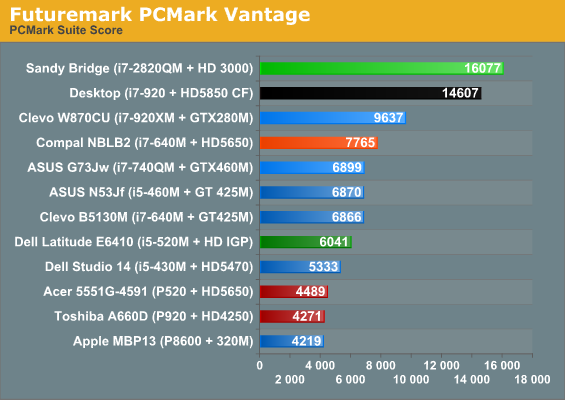
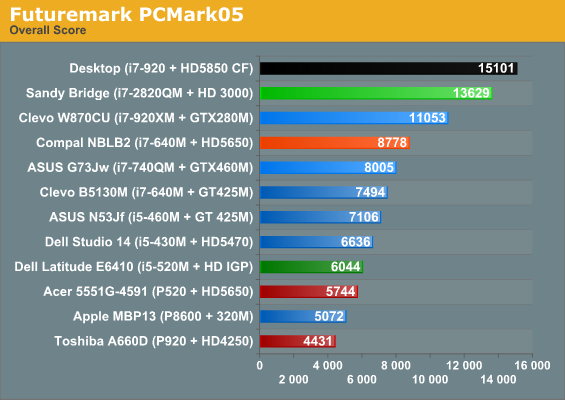
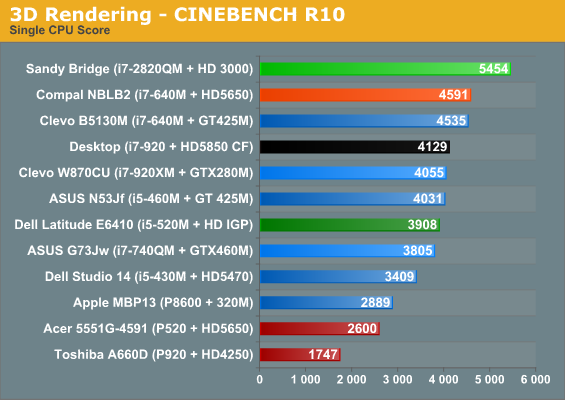
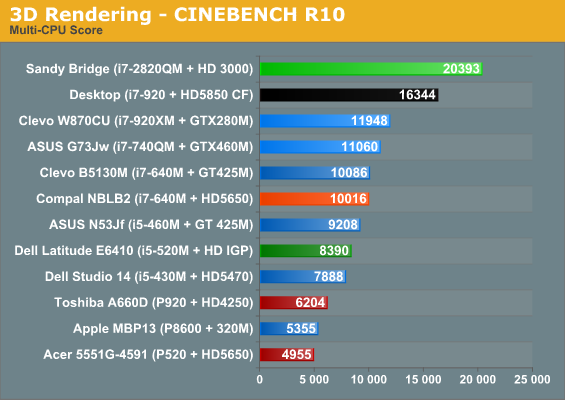
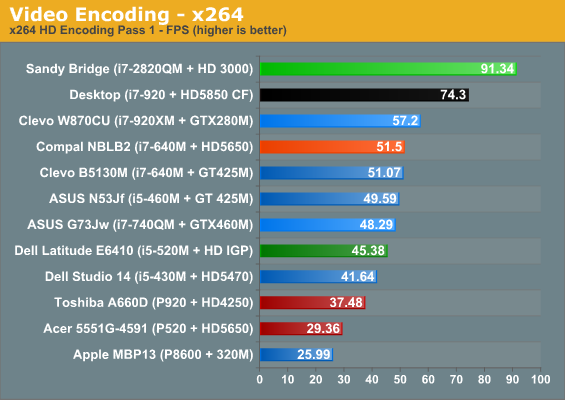

So, is anyone as impressed as I am? Sure, hex-core Gulftown is still the fastest game in town, and the desktop Sandy Bridge chips are obviously going to beat the mobile chips, but check out the scores relative to the i7-920 in my own “for play” system. (Incidentally, my “for work” system is actually running QX6700 still, and it does even worse! But all I do there is type documents and surf the web.) Let’s talk percentages here just to put it all into perspective.
Since PCMark Vantage and 05 are susceptible to heavy SSD influence, we’ll just skip those scores; suffice it to say that Sandy Bridge is no slouch there. Turn to CPU-intensive benchmarks, however, and we can really see the changes. Starting with single-threaded Cinebench, the new i7-2820QM checks in 35% faster than the outgoing i7-920XM, 32% faster than a desktop i7-920, 43% faster than the i7-740QM, and 19% faster than the previous generation’s fastest dual-core part.
Use applications that are thread-friendly and the gap widens even more. In Cinebench SMP, the closest competitor in our charts is the desktop i7-920, and 2820QM maintains a healthy 23% lead—in fact, looking at our desktop reviews, the stock (but with Turbo) 2820QM is roughly equal to an i7-930 overclocked to 3.5GHz. It also leads the i7-920XM by 84%, and an i7-640M by 104% (!). x264 encoding tells a similar story: the second pass is 9% faster than i7-920 desktop, 65% faster than i7-920XM, and twice as fast as i7-640M—and that’s without using the new QuickSync technology! [Whoa, nice segue Batman!]










66 Comments
View All Comments
JarredWalton - Monday, January 3, 2011 - link
All of the mobile chips list AES/TXT/vPRO support, unlike the desktop chips. They also all support Quick Sync and have 12 EUs.DesktopMan - Monday, January 3, 2011 - link
What about virtualization? Not sure why you are mentioning vPro, the requirement for vPro is usually the chipset, in this case QM67.JarredWalton - Monday, January 3, 2011 - link
They don't specifically break out VT-d and VT-x on the mobile products; all the slides state is that the mobile products support virtualization. On the desktop slide, they have a line saying "vPro/TXT/VT-d/SIPP" but on mobile slides the line says "AES/TXT/vPro". There's a second line for both desktops and mobile chips that just says "Intel Virtualization Technology" but it's not too useful since it just says "Yes" on every single Sandy Bridge CPU listed. :-\Hrel - Monday, January 3, 2011 - link
finally gaming on IG. Sooo, when do new Nvidia Gpu's come out for laptops?JarredWalton - Monday, January 3, 2011 - link
Check back on Jan 6. :-pmobomonster - Monday, January 3, 2011 - link
AMD is toast. Those are blistering performance numbers that even I did not expect. Incredible that it manages near 30 fps in several games at medium detail settings.The lower power dual core Sandy Bridge models will really put the squeeze on AMD. Even a regular 2520M will give AMD's Brazos a lot of trouble.
tipoo - Monday, January 3, 2011 - link
Bah, AMD has been toast for years now, if they really were, they would be buttered and eaten already.yes, horrible metaphor is horrible.
Kangal - Monday, January 3, 2011 - link
I'm a tech enthusiast especially in the portable device scene, and I always nit-pick things.Which is the reason why I own the Acer 4810TG.
The Core i7 640-UM would be my favourite processor, until I saw this.
The successor, 2657M, seems to have (theoretical) performance improvement of 19% and battery saving of 6%, which is very amazing.
From pure guestimation, this is ~200% (or slightly more) performance of the SU7300 at the same battery life. Whoa!
This would mean new ultra-portable devices (less than 14" and over 6 hours battery life).
If this gets partnered with the ATi 5650 (or its successor), this will bring serious gaming potential to ultra-portable devices *drools*
------
BUT, I wish they could add another chip on that (ULV) list.
The exact same thing as the i7 2657M but tossing the dual-core setup for a single core, if it meant they could increase the down the battery life by 70%. (Name it the 1357M?)
I mean, how about real 10 hours battery life (6 cell) on something about as fast as the SU7300 ??
Something like that (Core i7 1357M?) could make Windows7 tablets a more viable option.
davepermen - Monday, January 3, 2011 - link
I'd prefer a dualcore with 1ghz, or even 800mhz. as it could still clock to 2ghz or so, it would be fast when needed, but very battery saving else.if intel would go down further, it would most likely by now kill atom in the netbook and tablet area. and in the phone area, atom isn't there yet.
personally, i hate atom for being in the way. ultralow core i1 would be AWESOME.
JarredWalton - Monday, January 3, 2011 - link
SpeedStep lets all the SNB processors (mobile versions at least) run at 800MHz when they're not doing anything else. So you've already got what you're asking for, more or less.